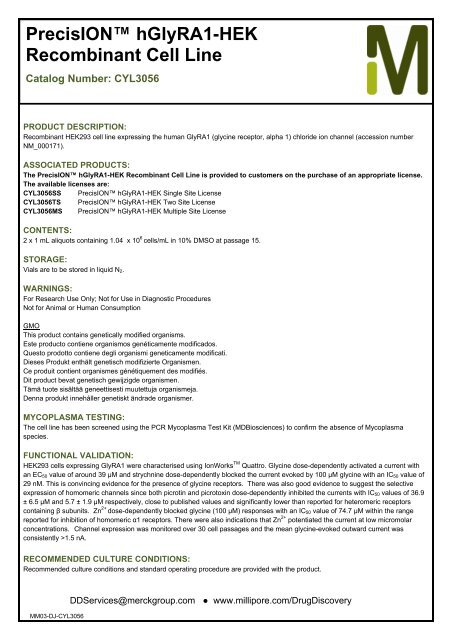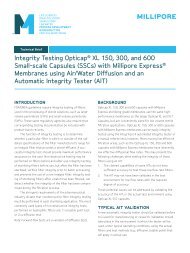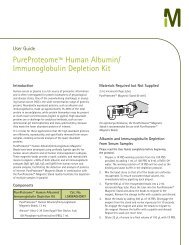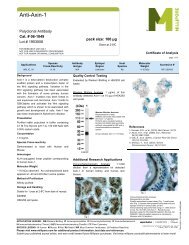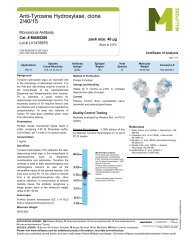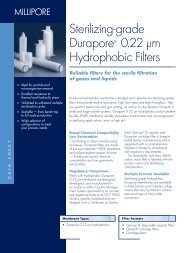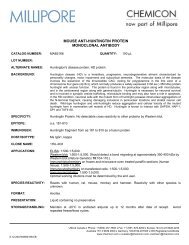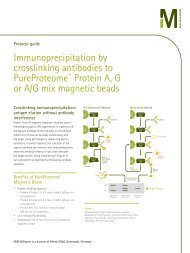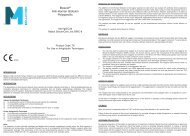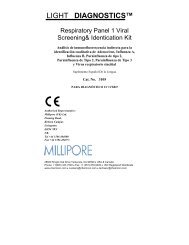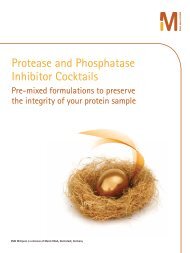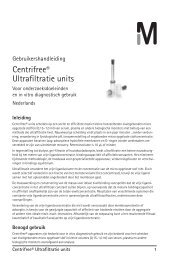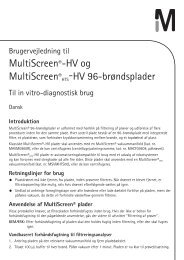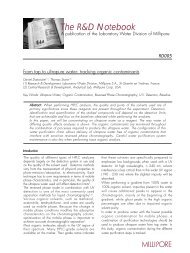PrecisION™ hGlyRA1-HEK Recombinant Cell Line - Millipore
PrecisION™ hGlyRA1-HEK Recombinant Cell Line - Millipore
PrecisION™ hGlyRA1-HEK Recombinant Cell Line - Millipore
Create successful ePaper yourself
Turn your PDF publications into a flip-book with our unique Google optimized e-Paper software.
PrecisION <strong>hGlyRA1</strong>-<strong>HEK</strong><br />
<strong>Recombinant</strong> <strong>Cell</strong> <strong>Line</strong><br />
Catalog Number: CYL3056<br />
PRODUCT DESCRIPTION:<br />
<strong>Recombinant</strong> <strong>HEK</strong>293 cell line expressing the human GlyRA1 (glycine receptor, alpha 1) chloride ion channel (accession number<br />
NM_000171).<br />
ASSOCIATED PRODUCTS:<br />
The PrecisION <strong>hGlyRA1</strong>-<strong>HEK</strong> <strong>Recombinant</strong> <strong>Cell</strong> <strong>Line</strong> is provided to customers on the purchase of an appropriate license.<br />
The available licenses are:<br />
CYL3056SS PrecisION <strong>hGlyRA1</strong>-<strong>HEK</strong> Single Site License<br />
CYL3056TS PrecisION <strong>hGlyRA1</strong>-<strong>HEK</strong> Two Site License<br />
CYL3056MS PrecisION <strong>hGlyRA1</strong>-<strong>HEK</strong> Multiple Site License<br />
CONTENTS:<br />
2 x 1 mL aliquots containing 1.04 x 10 6 cells/mL in 10% DMSO at passage 15.<br />
STORAGE:<br />
Vials are to be stored in liquid N2.<br />
WARNINGS:<br />
For Research Use Only; Not for Use in Diagnostic Procedures<br />
Not for Animal or Human Consumption<br />
GMO<br />
This product contains genetically modified organisms.<br />
Este producto contiene organismos genéticamente modificados.<br />
Questo prodotto contiene degli organismi geneticamente modificati.<br />
Dieses Produkt enthält genetisch modifizierte Organismen.<br />
Ce produit contient organismes génétiquement des modifiés.<br />
Dit product bevat genetisch gewijzigde organismen.<br />
Tämä tuote sisältää geneettisesti muutettuja organismeja.<br />
Denna produkt innehåller genetiskt ändrade organismer.<br />
MYCOPLASMA TESTING:<br />
The cell line has been screened using the PCR Mycoplasma Test Kit (MDBiosciences) to confirm the absence of Mycoplasma<br />
species.<br />
FUNCTIONAL VALIDATION:<br />
<strong>HEK</strong>293 cells expressing GlyRA1 were characterised using IonWorks TM Quattro. Glycine dose-dependently activated a current with<br />
an EC50 value of around 39 µM and strychnine dose-dependently blocked the current evoked by 100 µM glycine with an IC50 value of<br />
29 nM. This is convincing evidence for the presence of glycine receptors. There was also good evidence to suggest the selective<br />
expression of homomeric channels since both picrotin and picrotoxin dose-dependently inhibited the currents with IC50 values of 36.9<br />
± 6.5 µM and 5.7 ± 1.9 µM respectively, close to published values and significantly lower than reported for heteromeric receptors<br />
containing β subunits. Zn 2+ dose-dependently blocked glycine (100 µM) responses with an IC50 value of 74.7 µM within the range<br />
reported for inhibition of homomeric α1 receptors. There were also indications that Zn 2+ potentiated the current at low micromolar<br />
concentrations. Channel expression was monitored over 30 cell passages and the mean glycine-evoked outward current was<br />
consistently >1.5 nA.<br />
RECOMMENDED CULTURE CONDITIONS:<br />
Recommended culture conditions and standard operating procedure are provided with the product.<br />
MM03-DJ-CYL3056<br />
DDServices@merckgroup.com ● www.millipore.com/DrugDiscovery
PrecisION <strong>hGlyRA1</strong>-<strong>HEK</strong><br />
<strong>Recombinant</strong> <strong>Cell</strong> <strong>Line</strong><br />
Catalog Number: CYL3056<br />
FUNCTIONAL VALIDATION:<br />
Introduction.<br />
Inhibitory neurotransmission in the adult mammalian CNS is primarily mediated by the amino acids, GABA and glycine, causing an<br />
increase in Cl - conductance by binding to specific receptors; GABAA and Glycine receptors (GlyR) respectively. Like GABAA<br />
receptors, GlyRs belong to Cys-loop family of ligand-gated receptors that also includes nAChRs and 5HT3Rs.<br />
Members of this family exist as pentamers where the binding site for the ligand and the ion selective pore are part of the same<br />
molecule. To date 4 different α subunits and 1 β subunit have been identified that in specific combinations make up the various<br />
subtypes of GlyRs.<br />
In adult mammalian CNS, the most abundant subtype consists of the α1 and β subunit in a 3:2 stochiometry (Jensen, 2008). Such α1<br />
containing receptors have been shown to mediate fast inhibitory synaptic transmission in motor reflex circuits of the spinal cord,<br />
responsible for regulating muscle tone.<br />
Based on the location of GlyRs and their fundamental role in modulating excitatory inputs, compounds that potentiate glycine<br />
responses may result in novel muscle relaxants, sedatives and analgesics (Laube et al., 2002).<br />
Pharmacological Properties of <strong>hGlyRA1</strong>.<br />
IonWorks TM Quattro Electrophysiology.<br />
All pharmacological characterization was performed on IonWorks Quattro (PPC mode). The voltage protocol used is shown in Figure<br />
5. Under these conditions the glycine evoked Cl - current is quantified by subtracting the outward current at 0 mV prior to addition<br />
from the outward current in the presence of glycine. Note that prior to glycine addition the outward current at 0 mV is negligible.<br />
Using this novel approach it was possible to obtain a dose-response curve for glycine (Figure 1) and examine the dose-dependent<br />
effects of strychnine (Figure 2), picrotoxin, picrotin (Figure 3) and Zn 2+ (Figure 4) on the glycine (100 µM) evoked outward current.<br />
MM03-DJ-CYL3056<br />
DDServices@merckgroup.com ● www.millipore.com/DrugDiscovery
PrecisION <strong>hGlyRA1</strong>-<strong>HEK</strong><br />
<strong>Recombinant</strong> <strong>Cell</strong> <strong>Line</strong><br />
Catalog Number: CYL3056<br />
Glycine Dose-Response Curve:<br />
The EC50 value for glycine obtained with IonWorks is very similar to values recorded with more conventional methods. For example,<br />
in patch clamp experiments using homomeric α1 in LtK cells an EC50 of 100 µM was obtained (Wick et al., 1999) whereas in <strong>HEK</strong>293<br />
cells value of around 50- 60 µM have been reported (Han et al., 2004, Slaughter, 2003 and Li and Slaughter, 2007).<br />
Figure 1. Glycine Dose-Response Curve.<br />
Increasing concentrations of glycine were added to separate patch-plate wells and the evoked outward current at 0<br />
mV was measured. Glycine dose-dependently increased the outward current with an EC50 of 39 µM.<br />
Effect of Strychnine on Glycine-evoked Current:<br />
Strychnine has been shown to competitively antagonise glycine receptors in the nanomolar range in both native<br />
tissues (McCool and Botting, 2000, Sergeeva, 1998 and Tapia et al., 1998) and in recombinant cell lines<br />
(Grudzinska, 2005 and Jensen, 2005). The IC50 value of 29 nM obtained here (Figure 2), assessing the effects of<br />
various concentrations of strychnine on the response evoked by 100 µM glycine, is consistent with these reports.<br />
Figure 2. Effect of Strychnine on Glycine-evoked Currents.<br />
Various concentrations of strychnine were incubated for 100 s and then in the presence of 100 µM glycine.<br />
Strychnine dose-dependently inhibited glycine evoked outward currents with an IC50 of 29 nM.<br />
MM03-DJ-CYL3056<br />
DDServices@merckgroup.com ● www.millipore.com/DrugDiscovery
PrecisION <strong>hGlyRA1</strong>-<strong>HEK</strong><br />
<strong>Recombinant</strong> <strong>Cell</strong> <strong>Line</strong><br />
Catalog Number: CYL3056<br />
Effect of Picrotin and Picrotoxin on Glycine-evoked Currents:<br />
The plant alkaloid picrotoxin, is an equimolar mixture of picrotin and picrotoxinin. However, although both these<br />
constituents inhibit glycine receptors only picrotoxinin blocks GABAA receptors. Furthermore, both picrotin and<br />
picrotixin have been reported to be much more effective as antagonists against homomeric rather than heteromeric<br />
receptors (Burzomato et al., 2007, Li and Slaughter, 2007). For example, using picrotin, Li and Slaughter obtained<br />
an IC50 value of 38 µM at homomeric α1 receptors whereas at heteromeric receptors, containing β subunits, the<br />
value was >100 µM. Similarly, using picrotoxin, Burzomato et al., 2007 obtained an IC50 value of 6 µM at<br />
homomeric receptors and around 150 µM at heteromeric receptors. Hence, these compounds are useful<br />
pharmacological tools, not only for establishing the presence of glycine receptors but also for gaining an<br />
understanding of subunit composition. The IC50 values obtained using IonWorks are almost identical to the<br />
published values described above for both picrotoxin and picrotin. This provides convincing evidence for the<br />
expression of homomeric glycine receptors in this cell line.<br />
Figure 3. Effect of Picrotoxin and Picrotin on Glycine-evoked Currents.<br />
Various concentrations of compound were incubated for 100 s and then in the presence of 100 µM glycine.<br />
Picrotoxin and picrotin dose-dependently inhibited glycine evoked outward currents with IC50 values of 5.7 µM and<br />
36.9 µM respectively.<br />
MM03-DJ-CYL3056<br />
DDServices@merckgroup.com ● www.millipore.com/DrugDiscovery
PrecisION <strong>hGlyRA1</strong>-<strong>HEK</strong><br />
<strong>Recombinant</strong> <strong>Cell</strong> <strong>Line</strong><br />
Catalog Number: CYL3056<br />
Effect of Zn 2+ on Glycine-evoked Currents:<br />
Zinc ions may have a physiological role modulating glycine responses as well as other ion channels located certain<br />
synaptic regions since they have been found to be packaged into synaptic vesicles and released upon nerve<br />
stimulation. Zn 2+ has been reported to have a biphasic effect – a potentiating effect at low concentrations (0.5–10<br />
µM) and an inhibitory effect at higher concentrations (50–100 µM, Bloomenthal et al., 1994, Harvey et al., 1999<br />
and Miller et al., 2005). Reported IC50 values for the inhibitory effect of homomeric α1 vary somewhat, 10-20 µM<br />
(Miller et al., 2005) to around 500 µM (Harvey et al., 1999).<br />
Using IonWorks, a slight potentiation by Zn 2+ could be detected at the lowest concentrations (0.14-10 µM). The<br />
mean glycine-evoked outward current amplitude in the presence of Zn 2+ was in excess of 1.8 nA, approximately<br />
200 pA greater than in the absence of Zn 2+ . Higher concentrations dose-dependently inhibited the current with an<br />
IC50 value of around 75 µM. Thus the biphasic effect within reported ranges could be detected.<br />
Figure 4. Effect of Zn 2+ on Glycine-evoked Currents.<br />
Various concentrations of Zn 2+ were incubated for 100 s and then in the presence of 100 µM glycine. Zn 2+ dosedependently<br />
inhibited glycine evoked outward currents with an estimated IC50 value of 74.7 µM. Between 1 and 10<br />
µM Zn 2+ the mean outward current evoked by 100 µM glycine was >1.8 nA whereas in the absence of Zn 2+ the<br />
mean current was around 1.6 nA.<br />
MM03-DJ-CYL3056<br />
DDServices@merckgroup.com ● www.millipore.com/DrugDiscovery
PrecisION <strong>hGlyRA1</strong>-<strong>HEK</strong><br />
<strong>Recombinant</strong> <strong>Cell</strong> <strong>Line</strong><br />
Catalog Number: CYL3056<br />
Stability of <strong>hGlyRA1</strong>-<strong>HEK</strong>293 <strong>Cell</strong> <strong>Line</strong>.<br />
IonWorks TM HT Electrophysiology.<br />
In order to monitor the stability of functional expression over time, IonWorks TM HT automated electrophysiology<br />
was used. Data from a representative cell is shown in Figure 5. Currents before and in the presence of Glycine<br />
(300 μM) were evoked using the voltage protocol shown below. Typically, glycine produces a large outward current<br />
on stepping to 0 mV (asterisk, red trace).<br />
Figure 5. Glycine evoked currents using IonWorks TM HT.<br />
Upper panel: typical current traces evoked before (black trace) and after (red trace) the application of 300 µM<br />
Glycine. The zero current level is shown by the black dotted line.<br />
Lower panel: Voltage protocol.<br />
MM03-DJ-CYL3056<br />
�<br />
The amplitude of the Glycine (300 µM) evoked current at 0 mV (red asterisk) was measured and the percent of<br />
cells expressing currents >500 pA at each cell passage and having a seal resistance ≥50 MOhms prior to glycine<br />
addition were determined (Figure 6). Functional expression measured in this manner was consistently >85% and<br />
stable for >30 passages (Figure 6, blue squares). In addition the mean current amplitude for <strong>hGlyRA1</strong> expressing<br />
cells was consistently >1.5 nA (Figure 6, red bars).<br />
DDServices@merckgroup.com ● www.millipore.com/DrugDiscovery
PrecisION <strong>hGlyRA1</strong>-<strong>HEK</strong><br />
<strong>Recombinant</strong> <strong>Cell</strong> <strong>Line</strong><br />
Catalog Number: CYL3056<br />
Figure 6. Stability of expression over passage.<br />
The blue squares show the percentage of cells expressing mean current amplitude of ≥ 500 pA at 0 mV in<br />
response to 300 µM glycine at cell passage 10 through to 30. The lower panel shows the mean current amplitude<br />
(red bars) and adjacent to these the number of these cells (number of cells expressing >500 pA / number of cells<br />
sealing >50 MOhms). The maximum n-number was 24 cells for passages 10 through to 28 and 48 cells at passage<br />
30.<br />
MM03-DJ-CYL3056<br />
Current Amplitude (nA)<br />
4.0<br />
3.5<br />
3.0<br />
2.5<br />
2.0<br />
1.5<br />
1.0<br />
0.5<br />
0.0<br />
18/19<br />
15/15<br />
16/16<br />
19/21<br />
14/15<br />
10 12 14 16 18 20 22 24 26 28 30<br />
DDServices@merckgroup.com ● www.millipore.com/DrugDiscovery<br />
19/20<br />
Passage Number<br />
10/10 12/13 20/21<br />
16/16<br />
36/37<br />
110<br />
100<br />
90<br />
80<br />
70<br />
60<br />
50<br />
40<br />
30<br />
20<br />
10<br />
0<br />
% Expression
PrecisION <strong>hGlyRA1</strong>-<strong>HEK</strong><br />
<strong>Recombinant</strong> <strong>Cell</strong> <strong>Line</strong><br />
Catalog Number: CYL3056<br />
Vector:<br />
MM03-DJ-CYL3056<br />
AhdI<br />
PvuI<br />
Amp<br />
4000<br />
PCIN5_NEWC<br />
4904 bps<br />
Polylinker: CMV-BamHI-NotI-<strong>hGlyRA1</strong>-AscI-ClaI-HpaI-EcoRI-IRES-neo<br />
3000<br />
HincII<br />
XhoI<br />
AvaI<br />
SphI<br />
HincII<br />
SspI<br />
<strong>hGlyRA1</strong>‐pCIN5<br />
polyA<br />
XbaI<br />
BclI<br />
<strong>hGlyRA1</strong> Sequence (Accession Number NM_000171):<br />
DDServices@merckgroup.com ● www.millipore.com/DrugDiscovery<br />
2000<br />
MluI<br />
HincII<br />
CMV promoter<br />
Neo<br />
1000<br />
BssHII<br />
SphI<br />
NdeI<br />
SnaBI<br />
IRES<br />
PstI<br />
BamHI<br />
ApaI<br />
NotI<br />
AvaI<br />
XhoI<br />
AscI<br />
BssHII<br />
NdeI<br />
ClaI<br />
HpaI<br />
HincII<br />
EcoRI
PrecisION <strong>hGlyRA1</strong>-<strong>HEK</strong><br />
<strong>Recombinant</strong> <strong>Cell</strong> <strong>Line</strong><br />
Catalog Number: CYL3056<br />
References:<br />
Bloomenthal, A.B., Goldwater, E., Pritchett, D.B. and Harrison, N.L. (1994). Biphasic modulation of the strychninesensitive<br />
glycine receptor by Zn 2+ . Mol Pharmacol 46, 1156-1159.<br />
Burzomato, V., Groot-Kormelink, P.J., Sivilotti, L.G. and Beato, M. (2003). Stoichiometry of recombinant<br />
heteromeric glycine receptors revealed by a pore-lining region point mutation. Receptors Channels 9, 353-361.<br />
Grudzinska, J., Schemm, R., Haeger, S., Nicke, A., Schmalzing, G., Betz, H. and Laube, B. (2005). The beta<br />
subunit determines the ligand binding properties of synaptic glycine receptors. Neuron 45, 727-739.<br />
Han, Y., Li, P. and Slaughter, M.M. (2004). Selective antagonism of rat inhibitory glycine receptor subunits. J<br />
Physiol 554, 649-658.<br />
Harvey, R.J., Thomas, P., James, C.H., Wilderspin, A. and Smart, T.G. (1999). Identification of an inhibitory Zn 2+<br />
binding site on the human glycine receptor alpha1 subunit. J Physiol 520 Pt 1, 53-64.<br />
Jensen, A.A. (2005). Functional characterisation of human glycine receptors in a fluorescence-based high<br />
throughput screening assay. Eur J Pharmacol 521, 39-42.<br />
Jensen, A.A., Gharagozloo, P., Birdsall, N.J. and Zlotos, D.P. (2006). Pharmacological characterisation of<br />
strychnine and brucine analogues at glycine and alpha7 nicotinic acetylcholine receptors. Eur J Pharmacol 539,<br />
27-33.<br />
Laube, B., Maksay, G., Schemm, R. and Betz, H. (2002). Modulation of glycine receptor function: a novel approach<br />
for therapeutic intervention at inhibitory synapses? Trends Pharmacol Sci 23, 519-527.<br />
Li, P. and Slaughter, M. (2007). Glycine receptor subunit composition alters the action of GABA antagonists. Vis<br />
Neurosci 24, 513-521.<br />
McCool, B.A. and Botting, S.K. (2000). Characterization of strychnine sensitive glycine receptors in acutely isolated<br />
adult rat basolateral amygdala neurons. Brain Res 859, 341-351.<br />
Miller, P.S., Beato, M., Harvey, R.J. and Smart, T.G. (2005). Molecular determinants of glycine receptor alphabeta<br />
subunit sensitivities to Zn 2+ -mediated inhibition. J Physiol 566, 657-670.<br />
Sergeeva, O.A. (1998). Comparison of glycine- and GABA-evoked currents in two types of neurons isolated from<br />
the rat striatum. Neurosci Lett 243, 9-12.<br />
Tapia, J.C. and Aguayo, L.G. (1998). Changes in the properties of developing glycine receptors in cultured mouse<br />
spinal neurons. Synapse 28, 185-194.<br />
Webb, T.I. and Lynch, J.W. (2007). Molecular pharmacology of the glycine receptor chloride channel. Curr Pharm<br />
Des 13, 2350-2367.<br />
Wick, M.J., Bleck, V., Whatley, V.J., Brozowski, S.J., Nixon, K., Cardoso, R.A. and Valenzuela, C.F. (1999). Stable<br />
expression of human glycine alpha1 and alpha2 homomeric receptors in mouse L(tk-) cells. J Neurosci Methods<br />
87, 97-103.<br />
MM03-DJ-CYL3056<br />
DDServices@merckgroup.com ● www.millipore.com/DrugDiscovery
PrecisION <strong>hGlyRA1</strong>-<strong>HEK</strong><br />
<strong>Recombinant</strong> <strong>Cell</strong> <strong>Line</strong><br />
Catalog Number: CYL3056<br />
MM03-DJ-CYL3056<br />
For research use only; not for use as a diagnostic.<br />
Unless otherwise stated in our catalog or other company documentation accompanying the product(s), our<br />
products are intended for research use only and are not to be used for any other purpose, which includes but is not<br />
limited to, unauthorized commercial uses, in vitro diagnostic uses, ex vivo or in vivo therapeutic uses or any type of<br />
consumption or application to humans or animals.<br />
Certain methods of sample preparation, screening, analysis or use of <strong>Millipore</strong> products may be covered by<br />
patents or other intellectual property rights held by others in various jurisdictions. <strong>Millipore</strong> does not encourage or<br />
support any unauthorized or unlicensed use of any third-party owned technology. In particular, <strong>Millipore</strong> does not<br />
presently possess a license to any patents relating to the use of <strong>Millipore</strong> products in compound screening.<br />
Purchase of any <strong>Millipore</strong> product does not imply or grant a license to any such patent to our customers.<br />
©2009: <strong>Millipore</strong> Corporation. All rights reserved. No part of these works may be reproduced in any form without<br />
permission in writing.<br />
PatchXpress ® is a trademark of Molecular Devices Corporation<br />
DDServices@merckgroup.com ● www.millipore.com/DrugDiscovery


